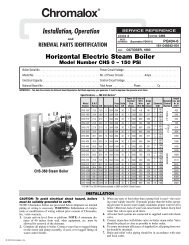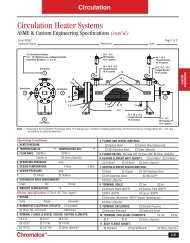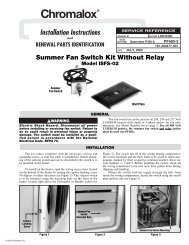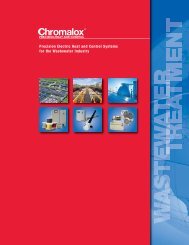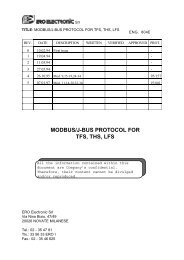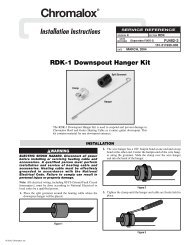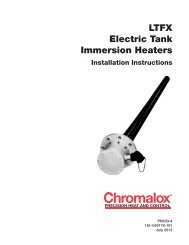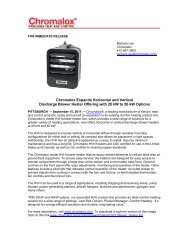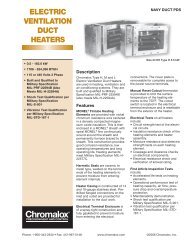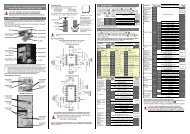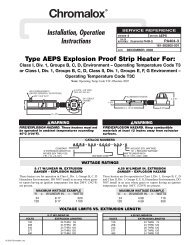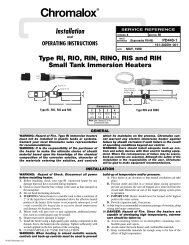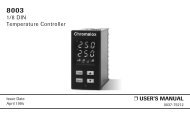Cold Weather Catalog - Chromalox Precision Heat and Control
Cold Weather Catalog - Chromalox Precision Heat and Control
Cold Weather Catalog - Chromalox Precision Heat and Control
- No tags were found...
Create successful ePaper yourself
Turn your PDF publications into a flip-book with our unique Google optimized e-Paper software.
TechnicalTechnical InformationDetermining <strong>Heat</strong> Energy RequirementsGeneral ApplicationsThe objective of any heating application is toraise or maintain the temperature of a solid,liquid or gas to or at a level suitable for aparticular process or application. Most heatingapplications can be divided into two basicsituations; applications which require themaintenance of a constant temperature <strong>and</strong>applications or processes which require workproduct to be heated to various temperatures.The principles <strong>and</strong> calculation procedures aresimilar for either situation.Constant Temperature ApplicationsMost constant temperature applications arespecial cases where the temperature of a solid,liquid or gas is maintained at a constant valueregardless of ambient temperature. Designfactors <strong>and</strong> calculations are based on steadystate conditions at a fi xed difference in temperature.<strong>Heat</strong> loss <strong>and</strong> energy requirementsare estimated using “worst case” conditions.For this reason, determining heat energyrequirements for a constant temperature applicationis relatively simple. Comfort heating(constant air temperature) <strong>and</strong> freeze protectionfor piping are typical examples of constanttemperature applications. The equations <strong>and</strong>procedures for calculating heat requirementsfor several applications are discussed later inthis section.Variable Temperature ApplicationsVariable temperature (process) applicationsusually involve a start-up sequence <strong>and</strong> havenumerous operating variables. The total heatenergy requirements for process applicationsare determined as the sum of these calculatedvariables. As a result, the heat energycalculations are usually more complex thanfor constant temperature applications. Thevariables are:Total <strong>Heat</strong> Energy Absorbed — The sum of allthe heat energy absorbed during start-up oroperation including the work product, thelatent heat of fusion (or vaporization), makeup materials, containers <strong>and</strong> equipment.Total <strong>Heat</strong> Energy Lost — The sum of theheat energy lost by conduction, convection,radiation, ventilation <strong>and</strong> evaporation duringstart-up or operation.Design Safety Factor — A factor to compensatefor unknowns in the process or application.Process ApplicationsThe selection <strong>and</strong> sizing of the installedequipment in a process application is basedon the larger of two calculated heat energyrequirements. In most process applications,the start-up <strong>and</strong> operating parameters representtwo distinctly different conditions in thesame process. The heat energy required forstart-up is usually considerably different thanthe energy required for operating conditions.In order to accurately assess the heat requirementsfor an application, each condition mustbe evaluated. The comparative values aredefi ned as follows:• Calculated heat energy required for processstart-up over a specifi c time period.• Calculated heat energy required tomaintain process temperatures <strong>and</strong>operating conditions over a specifi c cycletime.Determining <strong>Heat</strong> Energy AbsorbedThe fi rst step in determining total heat energyrequirements is to determine the heat energyabsorbed. If a change of state occurs as adirect or indirect part of the process, the heatenergy required for the change of state mustbe included in the calculations. This rule applieswhether the change occurs during startupor later when the material is at operatingtemperature. Factors to be considered in theheat absorption calculations are shown below:Start-Up Requirements (Initial <strong>Heat</strong>-Up)• <strong>Heat</strong> absorbed during start-up by:• Work product <strong>and</strong> materials• Equipment (tanks, racks, etc.)• Latent heat absorption at or during start-up:• <strong>Heat</strong> of fusion• <strong>Heat</strong> of vaporization• Time factorOperating Requirements (Process)• <strong>Heat</strong> absorbed during operation by:• Work product in process• Equipment loading (belts, racks, etc.)• Make up materials• Latent heat absorption during operation:• <strong>Heat</strong> of fusion• <strong>Heat</strong> of vaporization• Time (or cycle) factor, if applicableDetermining <strong>Heat</strong> Energy LostObjects or materials at temperatures abovethe surrounding ambient lose heat energy byconduction, convection <strong>and</strong> radiation. Liquidsurfaces exposed to the atmosphere lose heatenergy through evaporation. The calculation oftotal heat energy requirements must take theselosses into consideration <strong>and</strong> provide sufficientenergy to offset them. <strong>Heat</strong> losses are estimatedfor both start-up <strong>and</strong> operating conditions <strong>and</strong>are added into the appropriate calculation.<strong>Heat</strong> Losses at Start-Up — Initially, heatlosses at start-up are zero since thematerials <strong>and</strong> equipment are all at ambienttemperature. <strong>Heat</strong> losses increase to amaximum at operating temperature.Consequently, start-up heat losses are usuallybased on an average of the loss at start-up<strong>and</strong> the loss at operating temperature.<strong>Heat</strong> Losses at Operating Temperature —<strong>Heat</strong> losses are at a maximum at operatingtemperature. <strong>Heat</strong> losses at operatingtemperature are taken at full value <strong>and</strong> addedto the total energy requirements.Estimating <strong>Heat</strong> Loss FactorsThe heat losses just discussed can be estimatedby using factors from the charts <strong>and</strong>graphs provided in this section. Total lossesinclude radiation, convection <strong>and</strong> conductionfrom various surfaces <strong>and</strong> are expressed inwatts per hour per unit of surface area perdegree of temperature (W/hr/ft 2 /°F).Note — Since the values in the charts arealready expressed in watts per hour, they arenot infl uenced by the time factor “t” in the heatenergy equations.Design Safety FactorsIn many heating applications, the actual operatingconditions, heat losses <strong>and</strong> other factorsaffecting the process can only be estimated. Asafety factor is recommended in most calculationsto compensate for unknowns such asventilation air, thermal insulation, make up materials<strong>and</strong> voltage fl uctuations. As an example,a voltage fl uctuation (or drop) of 5% creates a10% change in the wattage output of a heater.Safety factors vary from 10 to 25% dependingon the level of confi dence of the designer in theestimate of the unknowns. The safety factor isapplied to the sum of the calculated values forheat energy absorbed <strong>and</strong> heat energy lost.178




